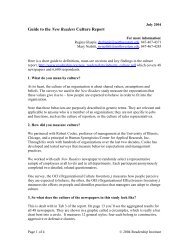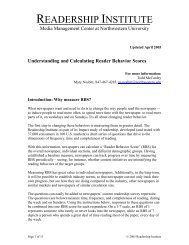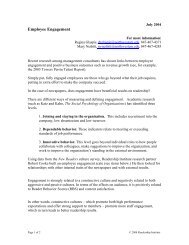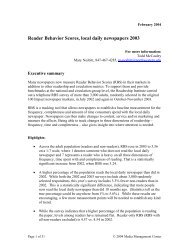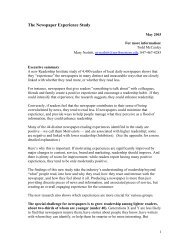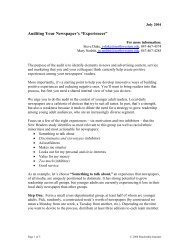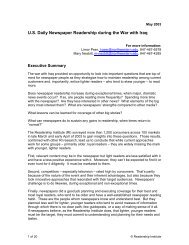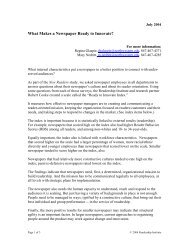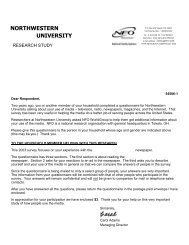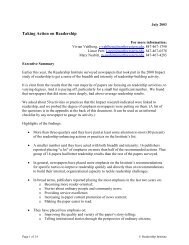A Conversation about Changing Newspaper Culture - Readership ...
A Conversation about Changing Newspaper Culture - Readership ...
A Conversation about Changing Newspaper Culture - Readership ...
You also want an ePaper? Increase the reach of your titles
YUMPU automatically turns print PDFs into web optimized ePapers that Google loves.
A <strong>Conversation</strong> <strong>about</strong> <strong>Changing</strong> <strong>Newspaper</strong> <strong>Culture</strong><br />
November 30, 2001<br />
For more information:<br />
Mary Nesbitt, 847-467-4285<br />
m-nesbitt@northwestern.edu<br />
The newspaper culture results from the Impact study of readership caught the attention of<br />
many in the industry when they were released a year ago. The picture wasn’t pretty.<br />
<strong>Newspaper</strong>s have a defensive culture that makes them slow to react to changes in the<br />
environment, focused on personal agendas rather than customer needs, and reluctant to<br />
work across departmental silos. (Detailed findings at<br />
www.readership.org/culture_management/culture/data/final_culture_report.pdf)<br />
But it was a message that resonated--newspaper people nodded in agreement when the<br />
descriptive evidence was laid out. And it was a message with some hope and motivation.<br />
A small number of newspapers in the study had cultures which, while still showing<br />
strong signs of defensiveness, had above-average constructive aspects.<br />
Most important of all, those mildly-constructive newspapers also tended to have higher<br />
readership and more of an external, reader orientation.<br />
A committee of the Associated Press Managing Editors, chaired by Peggy Kuhr of the<br />
The Spokesman-Review in Spokane, WA, was more than just interested in the results.<br />
Members were curious to know more <strong>about</strong> why culture--the behaviors that are expected,<br />
explicitly or implicitly, for people to fit into the working environment of a newspaper--<br />
should be of concern to editors.<br />
They wondered how newspapers can start to make the move from defensive to<br />
constructive. They asked whether there were lessons to be learned from other businesses<br />
that had attempted culture change in order to get better results.<br />
Working with the Institute, committee members interviewed several non-newspaper<br />
organizations that have been working on changing their cultures. Kuhr drew up a list of<br />
sharp questions and posed them to Mary Nesbitt, Managing Director of the <strong>Readership</strong><br />
Institute, and Robert Cooke, professor of management studies at the University of<br />
Page 1 of 10 ©2001 <strong>Readership</strong> Institute www.readership.org
Illinois, Chicago, who has made the study of organizational culture his life’s work and<br />
who partnered with the Institute to study newspapers.<br />
The full committee report was presented at the 2001 APME convention in Milwaukee in<br />
October and will be available online in early 2002. From that report, here is the dialogue<br />
among Kuhr, Cooke and Nesbitt.<br />
Q. Why should newspaper editors care <strong>about</strong> the results of the culture surveys?<br />
Nesbitt: I think newspaper editors know intuitively that what goes on inside the building<br />
and inside their newsrooms--how people work together and don’t work together--affects<br />
the news report in subtle and not-so-subtle ways. Think of some of the best, most<br />
rewarding, most exciting occasions in newsroom life. Election nights. Big breaking<br />
news. Complex and dramatic investigative pieces. Very rarely are they the product of a<br />
single person’s heroic endeavors. They come from a group of people in many different<br />
roles, committed to a single purpose--that of telling readers something important that they<br />
don’t know <strong>about</strong> something they, readers, care <strong>about</strong>. These are truly “constructive”<br />
occasions within a newsroom, where the greater good is top of mind.<br />
The trouble is, news people coalesce for these special occasions and then fly apart for the<br />
bulk of their working life. (It’s not just the newsroom; other departments are the same<br />
way too.) The key is to find ways to work more collaboratively more often, in the service<br />
of the reader. That is the challenge for editors and other newspaper leaders.<br />
And they should care, because constructive newspapers tend to also have higher<br />
readership. (They also have higher employee satisfaction and lower turnover.)<br />
It’s not just <strong>about</strong> working collaboratively within the newsroom, either. Constructive<br />
newspapers feel less threatened by working across departmental boundaries. They are<br />
able to do this without compromising important principles and integrity, probably<br />
because there is a better understanding across all departments <strong>about</strong> why and where lines<br />
have to be drawn.<br />
Q. We hear that, of all the industries Cooke has surveyed, newspapers' culture<br />
is most like that in the military and hospitals. What are the similarities?<br />
Cooke: There are striking similarities between many newspapers and military units along<br />
all three of the cultural styles measured by the Organizational <strong>Culture</strong> Inventory (OCI).<br />
First, Constructive norms--such as those for Self-Actualizing and Humanistic behaviors--<br />
are relatively weak in both types of organizations. Second, Aggressive norms are<br />
relatively strong and, like the military, expectations for Perfectionistic and Oppositional<br />
behaviors are particularly prevalent. Third, Passive norms are somewhat strong<br />
particularly with respect to Conventional and Avoidance styles.<br />
Page 2 of 10 ©2001 <strong>Readership</strong> Institute www.readership.org
We have observed the same pattern of styles in hospitals; however, not all of them exhibit<br />
this type of culture. We’re most likely to see these defensive and self-protective norms in<br />
hospitals where there is conflict between physicians, nurses and/or the administration,<br />
and where quality of care is viewed as below average.<br />
We’ve also seen this pattern of styles in other types of organizations including insurance,<br />
accounting, and manufacturing firms, but there is greater variance in the types of cultures<br />
found in such industries.<br />
Q. Should we (newspaper editors) be worried <strong>about</strong> those similarities, and your<br />
overall results?<br />
Nesbitt: I would be worried if newspaper editors thought that being this way was the<br />
only or the best way to fulfill the journalistic mission and serve readers. It’s true that<br />
many of the qualities of hospitals and the military are ones that drive to newspapers’<br />
credibility and the trust relationship with readers, like reliability and dependability. But<br />
newsrooms don’t have to be entirely regimented, hierarchical and rules-driven to<br />
accomplish the same ends.<br />
Editors have often noted, ruefully, that although newspapers write <strong>about</strong> change in the<br />
rest of the world, they are tremendously hide-bound in their own operations. The culture<br />
results indicate to me that some newspapers--a relatively small number but some--are<br />
making progress.<br />
I’m putting an interpretation on this, because we don’t have any comparable newspaper<br />
data from years past and this is the first extensive baseline measure of the industry. But I<br />
think what we are seeing is evolution, away from a culture that served newspapers well in<br />
a relatively stable past toward one that will enable them to be more responsive to a<br />
changing environment.<br />
What does worry me is whether the change is happening fast enough, given the growth of<br />
competition and the length of time--three decades or more--that we’ve been dogged by<br />
declining readership. We have that clichéd window of opportunity, but it is closing.<br />
Cooke: Should editors be worried? Apparently so, given that I’ve read some great<br />
articles (including, ironically, newspaper articles) that have been fairly critical of the<br />
culture of U.S. Army and Navy. One article that I read almost a decade ago linked the<br />
defensive culture of the Navy to everything ranging from accidents to sexual harassment.<br />
By the way, the reporter did such a fine job portraying the culture of the Navy that I<br />
thought he must have seen some of our OCI results for ships.<br />
More recently, I came across an interesting article on the Army, explaining the need for<br />
cultural change and the way in which traditional military norms interfere with the<br />
effective use of technology, information, and human resources.<br />
Page 3 of 10 ©2001 <strong>Readership</strong> Institute www.readership.org
It is possible that these Defensive cultural norms are necessary for military units and<br />
other reliability-oriented systems like nuclear power plants at certain times and under<br />
certain conditions. However, it is clear that the most effective of these organizations also<br />
exhibit relatively strong Constructive norms and that these norms are operative when<br />
appropriate. These latter conditions are most likely more prevalent in newspapers and,<br />
given the absence of such norms, there is likely some cause for concern.<br />
Q. What, specifically, surprised you <strong>about</strong> the results?<br />
Nesbitt: As an ex-editorial person, I wasn’t shocked to see newsrooms identified as<br />
defensive environments but I was surprised by the relative homogeneity of the results<br />
across departments. There is a shared newspaper culture, not very healthy, that crosses<br />
functional and departmental lines. There’s a positive in that--it’s not just newsrooms<br />
being, well, you know what newsrooms are like; it’s everybody doing things “the<br />
newspaper way.” This shared problem is in itself a piece of common ground on which to<br />
build.<br />
Another surprise: I expected to learn that smaller papers were more constructive and<br />
larger papers defensive. I saw it as an issue of scale. Wrong!<br />
Cooke: I certainly don’t know newspapers as well as Mary does and, therefore, I was<br />
surprised that so many of them had Defensive cultures. Generally, when we look at a<br />
sample of organizations from a specific industry, we find <strong>about</strong> the same number in each<br />
of four categories: Predominantly Constructive, Passive, Aggressive, and mixed. This<br />
certainly was not the case for the <strong>Readership</strong> sample; the number of Constructive papers<br />
turned out to be much smaller than I had expected.<br />
Q. If you were a newspaper editor, what you do after seeing the survey<br />
results?<br />
Cooke: Though you may not have meant it this way, I’m going to take your question<br />
literally. Playing out the aggressive cultural norms prevailing in many of the newspapers<br />
in the sample, I would first challenge the methods used to generate the results<br />
(Oppositional culture) and question the survey’s ability to tap the unique characteristics<br />
of news organizations (Perfectionistic).<br />
Alternatively, passive norms would prevail and I would rationalize the culture of my<br />
newspaper on the basis of the industry’s results (Conventional) and conclude that any<br />
changes I might initiate are likely to fail given the nature and state of the industry<br />
(Dependent).<br />
Page 4 of 10 ©2001 <strong>Readership</strong> Institute www.readership.org
I might then temporarily face reality given that the survey results strongly suggest that a<br />
more constructive culture is not only feasible, but also desirable and related to valued<br />
outcomes such as readership. Thus, I would charge my internal Human Resource group<br />
or engage external Organizational Development consultants, all of whom I can fire at will<br />
(Power), to constructively redirect the culture of the organization. And, as soon as<br />
possible, I would try to forget the whole thing (Avoidance) and move onto seemingly<br />
more pressing problems.<br />
That’s a worst-case scenario, of course. Perhaps Mary can present a more constructive<br />
alternative!<br />
Nesbitt: I like Rob’s answer because it’s the easy way out!<br />
He’s hit on an important point: responding to the culture results demands a countercultural<br />
response. I would make a real effort not to be defensive or explain away the<br />
results, but try to see my newsroom and the sorts of things we expect and encourage<br />
through an objective lens.<br />
I would talk with staff in small groups, share the results, ask questions and listen to their<br />
thoughtful observations on why things are the way they are and how they could be. I<br />
would make sure to always frame the discussion in the context of “making the<br />
organization more effective” (as opposed to, say, making this a more fun place to work).<br />
At the same time, I would make a really clear-eyed assessment of whether I had the<br />
management team working with me that could help make positive change. They need to<br />
share the vision, be able to translate it into actions and coach others. It is at this level that<br />
change efforts often fail. Leaders have the vision but they are reliant on the larger team to<br />
work it through. That would be my first step--getting an unvarnished picture of how<br />
things are, and whether change is possible with the current management team, before<br />
forming a plan and launching into action.<br />
Q. Should we assume that a constructive culture is good in today's<br />
fast-changing world; and defensive cultures are not?<br />
Cooke: Other studies consistently indicate that constructive and adaptive cultures are<br />
appropriate for such environments and the results from the Impact readership study<br />
indicate that this is the case for newspapers. The strength of Constructive norms was<br />
strongly and significantly related to respondents’ assessments of the adaptability of their<br />
newspapers. Similarly, in a separate survey using the Ideal form of the OCI, respondents<br />
specified Constructive norms as most appropriate for newspapers operating in today’s<br />
dynamic environment.<br />
Page 5 of 10 ©2001 <strong>Readership</strong> Institute www.readership.org
Q. Some people would argue that newsrooms work better when the culture is<br />
more perfectionistic and oppositional. After all, the public's biggest complaint<br />
<strong>about</strong> us is that we make too many mistakes, and there's a tradition of ``creative<br />
tension'' being an effective newsroom atmosphere. How would you respond?<br />
Cooke: A moderate oppositional and perfectionistic orientation can be useful,<br />
particularly if these cultural styles are reinforced by strong constructive norms. However,<br />
in most of the newspapers studied, oppositional and perfectionistic norms were stronger<br />
than moderate and norms for constructive behaviors were too weak to turn “tension” into<br />
“creative tension.”<br />
More generally, we have no credible evidence (from surveys administered in nuclear<br />
power plants, manufacturing firms, or hospitals) that oppositional and perfectionistic<br />
norms prevent mistakes, reduce accidents, or enhance members’ ability to respond to<br />
crises. Though one study in hospitals suggested that strong perfectionistic norms resulted<br />
in a lower rate of medication errors, the researcher dismissed these findings on the basis<br />
of inaccurate records. She explained that the perfectionistic norms in certain hospitals<br />
were so pervasive that the nurses simply could not or would not report errors. Besides<br />
messing up the results of the study, this trend almost ensured that the problems leading to<br />
the errors would not be identified or resolved in those hospitals.<br />
Thus, I would seriously question whether strengthening these defensive norms would<br />
reduce mistakes and readers’ complaints <strong>about</strong> mistakes. Perfectionistic norms, in<br />
particular, are more likely to instead encourage or require the appearance of competence,<br />
precision, and accuracy. For newspapers, this would translate into a tendency to present<br />
stories with a greater degree of certainty than the available information would warrant, to<br />
portray a greater mastery of the subject matter than justified, and to reluctantly<br />
acknowledge mistakes or do so in the least visible manner possible. Achievement and<br />
humanistic norms would have a more positive effect.<br />
Nesbitt: Being a perfectionist by nature and a journalist by training, I do think that some<br />
perfectionism is important. But the key word is “some”--at what point does it stop being<br />
useful and start being counter-productive? Newsroom editors know perfectionism has its<br />
limits. After all we are writing the first rough draft of history in 24-hour increments and<br />
never get it complete or right.<br />
Sometimes we are perfectionistic <strong>about</strong> entirely inappropriate things. I always think of a<br />
reporter, who shall remain nameless and who used to labor for hours over his ledes as<br />
deadlines drew nigh. When the copy was wrenched from his hand, the lede was no better<br />
than the one he’d written three hours earlier. It would make no difference to the reader.<br />
That’s perfectionism gone berserk.<br />
Page 6 of 10 ©2001 <strong>Readership</strong> Institute www.readership.org
Oppositional behavior is important in a newsroom too. We want critical<br />
thinkers who don’t accept things at face value, who turn over every rock and stone and<br />
who ask hard questions. But let’s remember, when we talk <strong>about</strong> organizational culture<br />
we’re talking <strong>about</strong> how people relate to each other in the workplace. And presumably<br />
we all are, or should be, on the same team. So it’s all in “how” people express<br />
disagreement or alternative points of view, and whether a critical pose becomes an<br />
ingrained, automatic reaction that fosters argument instead of problem-solving.<br />
Q. The surveys were completed by mid-2000--before this most recent<br />
series of layoffs and continuing difficult economic times for newspapers. If you surveyed<br />
the same newspapers today, do you think the results would be different?<br />
Nesbitt: The kinds of behavior expectations that the surveys measure are not much<br />
affected by the kind of economic downturn we have been experiencing. So the culture<br />
profiles would not change, nor would any of the “levers for change” – the kinds of<br />
practices that companies can embrace to bring <strong>about</strong> culture change.<br />
We found that job security--people, especially in editorial departments, feeling that their<br />
jobs are not in jeopardy--was a strength of newspapers vis-a-vis other businesses. It was<br />
one of the top three strengths, in fact. My hunch is, if the surveys were done now, it<br />
would still be a strength but not so near the top.<br />
Cooke: Organizations tend to “play out” their cultures when facing changing economic<br />
environments and the possible need for restructuring. That is, they take actions that are<br />
consistent with those that led to the emergence of their constructive or defensive cultures<br />
in the first place. Thus the administration of a survey today might produce results that<br />
differ in intensity but not in direction compared to those obtained last year.<br />
This continuity is exemplified in a positive way by a branch office of a high-tech<br />
company, known for its favorable culture, that we were scheduled to survey during a<br />
previous downturn. It turned out that the company decided to consolidate locations and<br />
started making arrangements to close this office. I was surprised that they decided to go<br />
ahead with the survey anyway and even more surprised to see that the culture remained<br />
so constructive. The sensitive and enlightened manner in which management handled the<br />
closing simply reinforced the positive norms that had evolved during better times.<br />
Q. Are there successful organizations with defensive cultures that you can<br />
name? What are they?<br />
Page 7 of 10 ©2001 <strong>Readership</strong> Institute www.readership.org
Cooke: There are quite a few successful organizations out there with defensive cultures,<br />
but they are successful despite rather than because of their cultures. The growth and<br />
profits realized by organizations result from a myriad of factors beyond culture--<br />
including ownership of patents and copyrights, geographical monopolies, historical<br />
dominance of markets, and being in the right place at the right time.<br />
Such advantages provide the organization with slack resources that, in turn, can allow<br />
management to get away with unenlightened leadership practices, sub-optimal<br />
technologies, counter-productive human resource systems, and/or rigid structures based<br />
on control and command. If management allows this to happen, these factors lead to and<br />
reinforce a defensive culture.<br />
When managers of such organizations are presented with their OCI results, they<br />
sometimes argue that defensive cultures must be good given that their firms are<br />
successful. I refer to this as the “misattribution of success to culture,” given that people<br />
tend to attribute success to themselves or things they have created (like culture).<br />
However, their organizations are “successful,” at least along certain criteria, despite<br />
rather than because of their cultures.<br />
I’m not going to name any of these organizations, but everyone can. Just think <strong>about</strong> the<br />
ones you know that seem to be doing quite well in terms of financial indicators but treat<br />
their customers, suppliers, and/or employees poorly. Though profitable, these<br />
organizations could be even more successful if their cultures were adaptive and their<br />
priorities better balanced for long-term effectiveness.<br />
Q. The APME <strong>Culture</strong> Committee has found that many companies suggest<br />
hiring an outside person if you want to change the organization's culture. What do<br />
you recommend and why?<br />
Nesbitt: I think third parties are often very useful in helping insiders get a relatively<br />
unbiased outside perspective. It is often the case that leaders in newspapers have come up<br />
through the ranks and, naturally, are products of the existing culture. Their challenge is to<br />
step outside it and lead it toward something very different. The tug of the familiar is very<br />
strong and leaders often need external support that they can trust.<br />
Staff take their cues from leaders and it is very important that leaders model the kind of<br />
behavior they want to encourage. This is another area where a disinterested third party<br />
can be helpful, as a kind of mentor.<br />
But at the end of the day, it is leaders who will create the conditions in which change can<br />
happen, not consultants.<br />
Cooke: It sometimes is necessary to bring a new leader in from the outside to effect<br />
cultural change. This approach can speed up the process but there are certain risks<br />
involved. Also, I’ve seen some fine examples of cultural change and organization<br />
Page 8 of 10 ©2001 <strong>Readership</strong> Institute www.readership.org
development effected by insiders. Typically, the leaders involved have used external<br />
consultants and transferred ideas from other industries to facilitate the transformation<br />
process.<br />
Q. Do you have any other advice?<br />
Nesbitt: The prospect of changing culture is very daunting and the temptation is to say<br />
it’s just too big to tackle. Let’s wait until the economy improves – yeah that’s it! I’m a<br />
big advocate of going at it in practical, concrete ways. Here’s a couple.<br />
First, look for something that the newsroom and the rest of the newspaper can rally<br />
around because it’s in everyone’s interests--like building readership. Under a fiat from<br />
the publisher, the team works cross-departmentally toward a real goal with real<br />
measurements. If people are being held accountable across departments, it’s in their best<br />
interests to work collaboratively and to succeed.<br />
Second, instead of trying to tackle all of the improvement areas at once, take them<br />
sequentially starting with the most crucial ones--i.e. where newspapers are performing<br />
worst. An example for most newspapers would be a couple of management practices--<br />
how people are selected and placed/promoted into jobs; and how people are trained and<br />
developed. And an important by-product of improving management practices is that<br />
culture will be positively affected as well.<br />
Cooke: One of the most important things for leaders to recognize is that practically<br />
everything they do has the potential to shape and reinforce the culture of their<br />
organization. This includes not only the ways they approach their jobs and their<br />
interactions with others but also the systems, structures, and technologies they implement<br />
or allow to take hold. Similarly, the actions they take to accomplish tasks in the shortterm<br />
can have a lasting impact on cultural norms and the organization’s ability to get<br />
work done over the long term.<br />
Thus, managers can re-direct the cultures of their organizations by considering the<br />
impact of their leadership styles, their decisions, and the structural and technological<br />
changes they implement on behavioral norms and expectations.<br />
Q. Can you recommend other reports or books <strong>about</strong> culture for editors who'd<br />
like to know more? Any other sources of information?<br />
Cooke: There are many great books out there. The classic on organizational culture and<br />
its impact on effectiveness is Corporate <strong>Culture</strong> and Performance by John P. Kotter and<br />
James L. Heskett, (New York: The Free Press, 1992). Another excellent book is The<br />
Knowing Doing Gap: How Smart Companies Turn Knowledge into Action by Jeffrey<br />
Pfeffer and Robert I. Sutton (Harvard Business School Press, 1999).<br />
Page 9 of 10 ©2001 <strong>Readership</strong> Institute www.readership.org
There’s an interesting report on the culture of the FAA that might be of interest given that<br />
newspapers share some of the reliability orientation of that agency. Prepared by the<br />
United States General Accounting Office, its title is Aviation Acquisition: A<br />
Comprehensive Strategy is Needed for Cultural Change at FAA (Washington DC, August<br />
1996, available on-line at www.gao.gov/archive/1996/rc96159.pdf).<br />
From an academic perspective, a wide range of thinking on culture is presented in The<br />
Handbook of Organizational <strong>Culture</strong> and Climate edited by Neil M. Askanasy, Celeste<br />
P.M. Wilderom, and Mark F. Peterson (Thousand Oaks, CA, 2000). For those explicitly<br />
interested in the outcomes of, and the factors causally related to the OCI styles, Janet L.<br />
Szumal has prepared the Organizational <strong>Culture</strong> Inventory Interpretation & Development<br />
Guide (Plymouth, MI: Human Synergistics, 1998).<br />
Finally, many of the popular business books on change directly or indirectly focus on<br />
organizational culture. These include Change the World (Robert E. Quinn, 2000),<br />
Leading Change (James O’Toole, 1995) and Champions of Change (David Nadler,<br />
1998), all published by Jossey-Bass (San Francisco).<br />
Page 10 of 10 ©2001 <strong>Readership</strong> Institute www.readership.org



